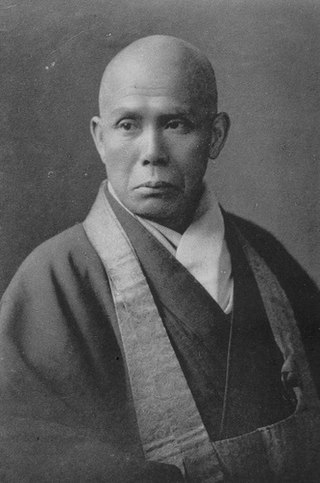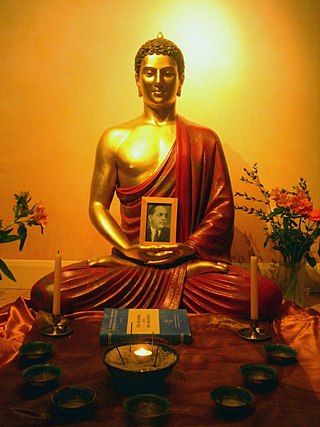
Nichiren Buddhism, also known as Hokkeshū, is a branch of Mahayana Buddhism based on the teachings of the 13th-century Japanese Buddhist priest Nichiren (1222–1282) and is one of the Kamakura period schools. Its teachings derive from some 300–400 extant letters and treatises either authored by or attributed to Nichiren.
Bhakti means "attachment, participation, fondness for, homage, faith, love, devotion, worship, purity". It was originally used in Hinduism, referring to devotion and love for a personal god or a representational god by a devotee. In ancient texts such as the Shvetashvatara Upanishad, the term simply means participation, devotion and love for any endeavor, while in the Bhagavad Gita, it connotes one of the possible paths of spirituality and towards moksha, as in bhakti marga.

Chinese Buddhism or Han Buddhism is a Chinese form of Mahāyāna Buddhism which draws on the Chinese Buddhist Canon as well as numerous Chinese traditions. Chinese Buddhism focuses on studying Mahayana sutras and Mahāyāna treatises and draws its main doctrines from these sources. Some of the most important scriptures in Chinese Buddhism include: Lotus Sutra, Flower Ornament Sutra, Vimalakirtī Sutra, Nirvana Sutra, and Amitābha Sutra. Chinese Buddhism is the largest institutionalized religion in Mainland China. Currently, there are an estimated 185 to 250 million Chinese Buddhists in the People's Republic of China. It is also a major religion in Taiwan, Singapore, and Malaysia, as well as among the Chinese Diaspora.
Buddhism in the West broadly encompasses the knowledge and practice of Buddhism outside of Asia in the Western world. Occasional intersections between Western civilization and the Buddhist world have been occurring for thousands of years. The first Westerners to become Buddhists were Greeks who settled in Bactria and India during the Hellenistic period. They became influential figures during the reigns of the Indo-Greek kings, whose patronage of Buddhism led to the emergence of Greco-Buddhism and Greco-Buddhist art. There was little contact between the Western and Buddhist cultures during most of the Middle Ages but the early modern rise of global trade and mercantilism, improved navigation technology and the European colonization of Asian Buddhist countries led to increased knowledge of Buddhism among Westerners. This increased contact led to various responses from Buddhists and Westerners throughout the modern era. These include religious proselytism, religious polemics and debates, Buddhist modernism, Western convert Buddhists and the rise of Buddhist studies in Western academia. During the 20th century, there was a growth in Western Buddhism due to various factors such as immigration, globalization, the decline of Christianity and increased interest among Westerners. The various schools of Buddhism are now established in all major Western countries making up a small minority in the United States, Europe, Australia and New Zealand.

Greco-Buddhism, or Graeco-Buddhism, is the cultural syncretism between Hellenistic culture and Buddhism, which developed between the 4th century BC and the 5th century AD in Gandhara, in present-day north-western Pakistan and parts of north-east Afghanistan.

Daisetsu Teitaro Suzuki, self-rendered in 1894 as "Daisetz", was a Japanese essayist, philosopher, religious scholar, translator, and writer. He was a scholar and author of books and essays on Buddhism, Zen and Shin that were instrumental in spreading interest in both Zen and Shin to the West. Suzuki was also a prolific translator of Chinese, Japanese, and Sanskrit literature. Suzuki spent several lengthy stretches teaching or lecturing at Western universities, and devoted many years to a professorship at Ōtani University, a Japanese Buddhist school.
The history of Buddhism can be traced back to the 5th century BCE. Buddhism arose in Ancient India, in and around the ancient Kingdom of Magadha, and is based on the teachings of the renunciate Siddhārtha Gautama. The religion evolved as it spread from the northeastern region of the Indian subcontinent throughout Central, East, and Southeast Asia. At one time or another, it influenced most of Asia.

Soyen Shaku was the first Zen Buddhist master to teach in the United States. He was a rōshi of the Rinzai school and was abbot of both Kenchō-ji and Engaku-ji temples in Kamakura, Japan. Soyen was a disciple of Imakita Kosen.

Paul Carus was a German-American author, editor, a student of comparative religion and philosopher.

Buddhism entered Han China via the Silk Road, beginning in the 1st or 2nd century CE. The first documented translation efforts by Buddhist monks in China were in the 2nd century CE via the Kushan Empire into the Chinese territory bordering the Tarim Basin under Kanishka. These contacts transmitted strands of Sarvastivadan and Tamrashatiya Buddhism throughout the Eastern world.
Buddhism, also known as Buddha Dharma, and Dharmavinaya, is an Indian religion or philosophical tradition based on teachings attributed to the Buddha. It originated in the eastern Gangetic plain as a śramaṇa–movement in the 5th century BCE, and gradually spread throughout much of Asia via the Silk Road. It is the world's fourth-largest religion, with over 520 million followers (Buddhists) who comprise seven percent of the global population.
Donald Sewell Lopez Jr. is the Arthur E. Link Distinguished university professor of Buddhist and Tibetan Studies at the University of Michigan, in the Department of Asian Languages and Cultures.

Buddhism and Hinduism have common origins in the culture of Ancient India. Buddhism arose in the Gangetic plains of Eastern India in the 5th century BCE during the "second urbanisation". Hinduism developed as a fusion or synthesis of practices and ideas from the ancient Vedic religion and elements and deities from other local Indian traditions. This Hindu synthesis emerged after the Vedic period, between 500-200 BCE and c. 300 CE, in or after the period of the Second Urbanisation, and during the early classical period of Hinduism, when the Epics and the first Puranas were composed.

Navayāna, otherwise known as Navayāna Buddhism, refers to the modern re-interpretation of Buddhism founded and developed by the Indian jurist, social reformer, and scholar B. R. Ambedkar; it is otherwise called Neo-Buddhism and Ambedkarite Buddhism.

Women in Buddhism is a topic that can be approached from varied perspectives including those of theology, history, anthropology, and feminism. Topical interests include the theological status of women, the treatment of women in Buddhist societies at home and in public, the history of women in Buddhism, and a comparison of the experiences of women across different forms of Buddhism. As in other religions, the experiences of Buddhist women have varied considerably.
Devotion, a central practice in Buddhism, refers to commitment to religious observances or to an object or person, and may be translated with Sanskrit or Pāli terms like saddhā, gārava or pūjā. Central to Buddhist devotion is the practice of Buddhānussati, the recollection of the inspiring qualities of the Buddha. Although buddhānussati was an important aspect of practice since Buddhism's early period, its importance was amplified with the arising of Mahāyāna Buddhism. Specifically, with Pure Land Buddhism, many forms of devotion were developed to recollect and connect with the celestial Buddhas, especially Amitābha.

In Buddhism, faith refers to a serene commitment to the practice of the Buddha's teaching, and to trust in enlightened or highly developed beings, such as Buddhas or bodhisattvas. Buddhists usually recognize multiple objects of faith, but many are especially devoted to one in particular, such as one particular Buddha. Faith may not only be devotion to a person, but exists in relation to Buddhist concepts like the efficacy of karma and the possibility of enlightenment.
Buddhist modernism are new movements based on modern era reinterpretations of Buddhism. David McMahan states that modernism in Buddhism is similar to those found in other religions. The sources of influences have variously been an engagement of Buddhist communities and teachers with the new cultures and methodologies such as "Western monotheism; rationalism and scientific naturalism; and Romantic expressivism". The influence of monotheism has been the internalization of Buddhist gods to make it acceptable in modern Western society, while scientific naturalism and romanticism has influenced the emphasis on current life, empirical defense, reason, psychological and health benefits.

Mahāyāna is a term for a broad group of Buddhist traditions, texts, philosophies, and practices developed in ancient India. It is considered one of the three main existing branches of Buddhism, the others being Theravāda and Vajrayāna. Mahāyāna accepts the main scriptures and teachings of early Buddhism but also recognizes various doctrines and texts that are not accepted by Theravada Buddhism as original. These include the Mahāyāna sūtras and their emphasis on the bodhisattva path and Prajñāpāramitā. Vajrayāna or Mantra traditions are a subset of Mahāyāna which makes use of numerous tantric methods Vajrayānists consider to help achieve Buddhahood.
Zen is a school of Mahayana Buddhism that originated in China during the Tang dynasty as the Chan School or the Buddha-mind school ," and later developed into various sub-schools and branches. From China, Chán spread south to Vietnam and became Vietnamese Thiền, northeast to Korea to become Seon Buddhism, and east to Japan, becoming Japanese Zen












